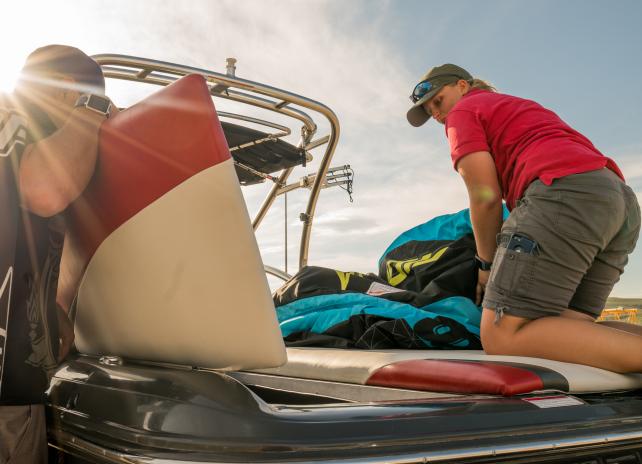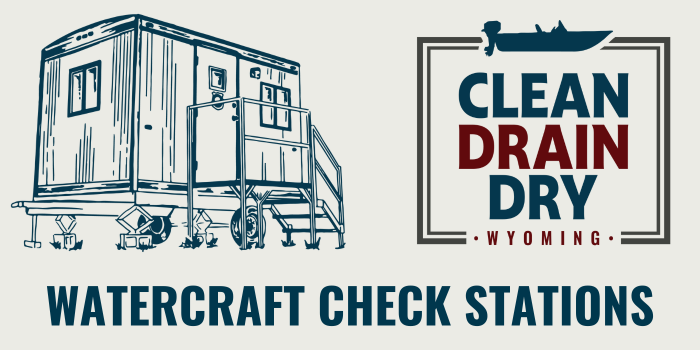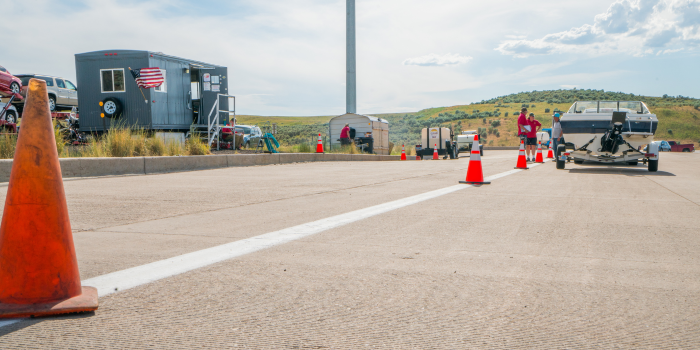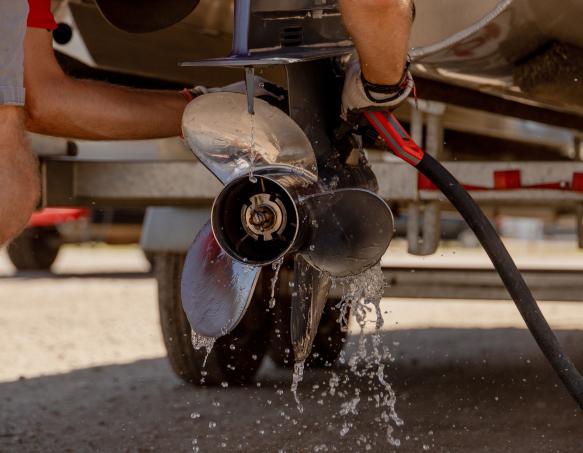
Watercraft inspection information
Each year Game and Fish inspects thousands of watercraft entering Wyoming from all 50 states. Watercraft inspections are crucial as the first line of defense against aquatic invasive species entering Wyoming’s waters.
Clean, Drain, Dry
When leaving a waterbody, remove all visible plant material and excess mud from the boat and trailer, pull all plugs for transport, allow all compartments to drain in between uses and lower the motor to completely drain. Ballast tanks, live wells and bilges are especially important to drain as water can pool and remain for long periods of time. Never move water, plants or animals from one body of water to another.
Watercraft inspections - What to expect
Game and Fish conducts watercraft inspections at ports of entry, other border locations and major waters around the state. These locations are marked with signs, and all persons transporting watercraft must stop at open check stations.
Authorized inspectors begin inspections by asking a few questions of the boater to determine the risk a watercraft poses in transporting AIS. If the watercraft is clean, drained and dry inspections typically take 3 to 5 minutes. The majority of Wyoming boaters can expect this level of inspection.
If the watercraft is determined to be high-risk, the inspection is more thorough and may take 10 to 30 minutes depending on the type and size of the watercraft. Thorough high-risk inspections are critical to keeping AIS out of Wyoming. Once a watercraft has passed inspection it is able to launch.
If the watercraft is found to contain high-risk standing water or is suspected of transporting any AIS, the watercraft will undergo a decontamination.



Watercraft decontaminations
If a watercraft is determined to need a decontamination, authorized personnel will thoroughly spray the watercraft exterior and flush interior compartments with scalding (120°F to 140°F) water to remove and kill any AIS that may be on the watercraft. No chemicals are used in this process.
After decontamination, the watercraft will be inspected again to ensure the process was successful. Watercraft that are heavily infested with AIS may require a quarantine to kill any AIS that may not have been killed during decontamination. Very few boats require decontamination and fewer require a quarantine.
Watercraft inspection FAQs
-
Answer
At an AIS check station, an authorized inspector will asks a few questions to determine the risk your watercraft poses of transporting AIS. If the watercraft is deemed low-risk, we will provide the owner with informational materials, inspect the watercraft and then seal the watercraft to launch. A watercraft deemed high-risk will need to undergo a more thorough inspection. High-risk watercraft may include those that last operated their watercraft in a state with waters known to have invasive mussels or watercraft with a large amount of standing water that could harbor larval mussels.
-
Answer
If you are transporting watercraft into Wyoming from March 1 through Nov. 30, your watercraft MUST be inspected before launching in Wyoming. At all other times of the year, your watercraft must be inspected if it has been on any water known to be infested with zebra or quagga mussels within the last 30 days. If you encounter a watercraft check station on your route of travel, it is also mandatory that you stop and have your watercraft inspected for AIS. Details on inspection locations and hours of operation can be found by clicking the link below. AIS Watercraft Inspection Locations
-
Answer
Permanent inspection locations exist at many ports of entry and other border locations. Inspectors are also available at major waters on a rotating basis. Wyoming Game and Fish Department regional offices can provide inspections during normal business hours. View details for watercraft inspection locations and hours of operation.
-
Answer
Having your boat cleaned, drained, and dried is the best way to keep from spreading AIS and will help expedite your inspection. Ensure all water is drained from the compartments and motor of your watercraft. Remove all plants and mud from the watercraft and trailer after leaving a waterbody.
Remove your bilge plug immediately upon leaving a waterbody and leave all plugs out during transport.
-
Answer
Yes, all persons transporting watercraft must stop at authorized AIS check stations that are established on their route of travel. This includes all motorized watercraft, all nonmotorized watercraft including raft, canoes, kayaks and paddleboards. Inflatable watercraft also need to be inspected before launching. Possession of an AIS decal does NOT take the place of an inspection.
-
Answer
No. Only an authorized inspector can decontaminate watercraft in Wyoming.
Car washes are not an effective method of decontaminating watercraft as the water does not reach the high temperatures needed to kill AIS, and the effluent may drain into the water and spread any AIS washed from the watercraft.
Chemicals like bleach have not been proven effective in killing all AIS and may damage watercraft and equipment.
-
Answer
Even if you already stopped and were inspected at a check station during your trip, you still must stop at all open check stations in Wyoming along your route of travel. If your boat has a valid seal and you have the corresponding receipt, you will not need to undergo another full inspection but you must stop at the check station.
Even if your boat is sealed upon entering Wyoming from another state, you still need to stop at all open check stations along your route.If you have a valid seal and receipt for your watercraft upon entering Wyoming, and you do not pass an open check station, you may still launch in Wyoming waters.

Purchased a boat?
If you recently purchased a boat from out of state, you could be unknowingly transporting AIS into Wyoming. Please contact the Wyoming Game and Fish Department at 1-877-WGFD-AIS if you purchased a boat from out of state.
